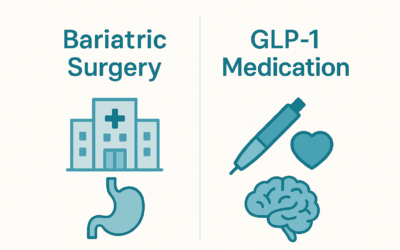If you’re considering medical weight loss and GLP-1 medications, you’ve probably come across two options: compounded semaglutide and Ozempic. But what, exactly, is the difference, and why might you choose one over the other? Let’s break it down so you know exactly what you’re getting — and why it matters.
What is compounded semaglutide?
Compounded semaglutide is a custom drug with semaglutide as the active ingredient, mixed and prepared by a compounding pharmacy. What does that mean? In simple terms, “compounding” means adjusting or combining ingredients to create a whole new medication. And although the active ingredient may be the same as the brand-name versions, the final product is not — it’s the compounding pharmacy’s custom formulation. Different compounding pharmacies will have different formulations, and none of them are exactly the same as the original brand-name semaglutide drugs. This means that compounded semaglutide drugs are not FDA-approved. They haven’t been through the same clinical trials as the branded drugs, and they haven’t been evaluated for safety and efficacy by the FDA.
What is Ozempic?
Ozempic is a brand-name medication developed by the drug company Novo Nordisk, and its active ingredient is semaglutide. It’s FDA-approved to help manage type 2 diabetes, and it’s also commonly prescribed off-label for weight loss. Ozempic comes as a once-weekly injection, designed to keep blood sugar stable while curbing appetite and promoting gradual weight loss.
When you choose Ozempic, you’re getting semaglutide in a fixed, pre-set dose. It’s been rigorously tested, approved, and packaged for straightforward, consistent use.
Compounded semaglutide vs. Ozempic: Are they the same?
No. They both use semaglutide as their active ingredient, but compounded semaglutide is not the same as Ozempic, and there are big differences in how the two medications are prepared, used, regulated, and prescribed.
- Ozempic is a standardized, ready-made, FDA-approved product. It’s been tested in clinical trials, and it’s guaranteed to be both safe and effective. It’s manufactured on a large scale, under strictly controlled conditions. Ozempic is designed for consistency, with set doses and an easy-to-use injection pen, making it simple to integrate into your weekly routine.
- Compounded semaglutide is made by the pharmacy on-site, and it’s not FDA-approved. Unlike Ozempic — which is identical no matter where it’s filled — compounded semaglutide can vary depending on the pharmacy and the specific medical reason it’s being prescribed. These versions haven’t been through the same clinical trials as the branded drugs, and they’re not guaranteed by the FDA to be safe or effective. That doesn’t mean they’re not useful or appropriate — it just means they’re held to a different regulatory standard and should only be prescribed when your provider determines there’s a clear medical reason to do so.
Why would you choose compounded semaglutide?
So why would you want or need to use compounded semaglutide? There are various reasons that your doctor might prescribe a compounded version. If you have an allergy or sensitivity to one of the ingredients in Ozempic or Wegovy, for example, your provider might prescribe a compounded medication in order to avoid the allergen. Or they might feel that you need a different dosage or delivery form than what’s available with the standard, off-the-shelf, name-brand versions. It all comes down to what your provider feels is medically most appropriate in your case.
Not everyone’s treatment needs fit neatly into the pre-determined doses that brand-name drugs provide. Compounding can allow for dose adjustments or ingredient modifications when medically necessary. It can also be a more accessible option when supply issues make brand-name versions harder — or even impossible — to get.
Why would someone choose Ozempic?
The appeal of Ozempic lies in its convenience and reliability. You know exactly what you’re getting — it’s a once-weekly shot with a preset dose, designed for easy use and consistent results. If you’re managing type 2 diabetes or using Ozempic off-label for weight loss, it’s a straightforward, predictable solution.
Key differences to consider
Customization vs. standardization:
- Ozempic is all about simplicity. It comes in a fixed dose, with everything pre-packaged for you. No adjustments, no extras—just a one-size-fits-all, easy-to-use product.
- Compounded semaglutide offers more flexibility (if medically appropriate, of course). It can be adjusted by the pharmacy when your provider feels a standard, off-the-shelf option isn’t the right fit.
Cost and accessibility:
- Compounded versions may save you money, especially if your insurance doesn’t cover Ozempic or if supply issues make it hard to find. Just keep in mind that compounded medications can only be prescribed when your provider determines they’re medically necessary, and that they’re not FDA-approved.
- Ozempic, as a brand-name, FDA-approved product, might come with a higher price tag, but it’s also covered by many insurance plans.
Trust and quality:
- Ozempic has been through extensive testing and has FDA approval, so there’s a level of trust and assurance that comes with it. You know what to expect, and you can rely on a proven product.
- Compounded semaglutide isn’t FDA-approved and hasn’t been through the same testing, but it can still be appropriate when prescribed for a specific medical need and prepared by a reputable compounding pharmacy.
Choosing the right option for you
The choice between compounded semaglutide and Ozempic comes down to your specific needs. Compounded semaglutide might be an option if your provider feels the standard, off-the-shelf version isn’t the right fit. On the other hand, if you want a straightforward, dependable, FDA-approved treatment with set doses, Ozempic provides that convenience and reliability.
At Claya, we’re all about giving you options that make sense for your journey. We offer both brand-name medications like Ozempic and compounded alternatives, so you and your provider have the freedom to choose what fits your needs best. Our goal is to help you understand your choices and make informed decisions — whether about the medication itself, the dose, or how you take it.
When it comes to compounded semaglutide vs. Ozempic, there’s no right or wrong — just what’s right for you. The active ingredient may be the same, but the medications themselves are not — and that’s why your provider’s guidance matters.
Learn more about Claya’s weight loss treatment programs, including compounded semaglutide for medically supervised weight loss.



